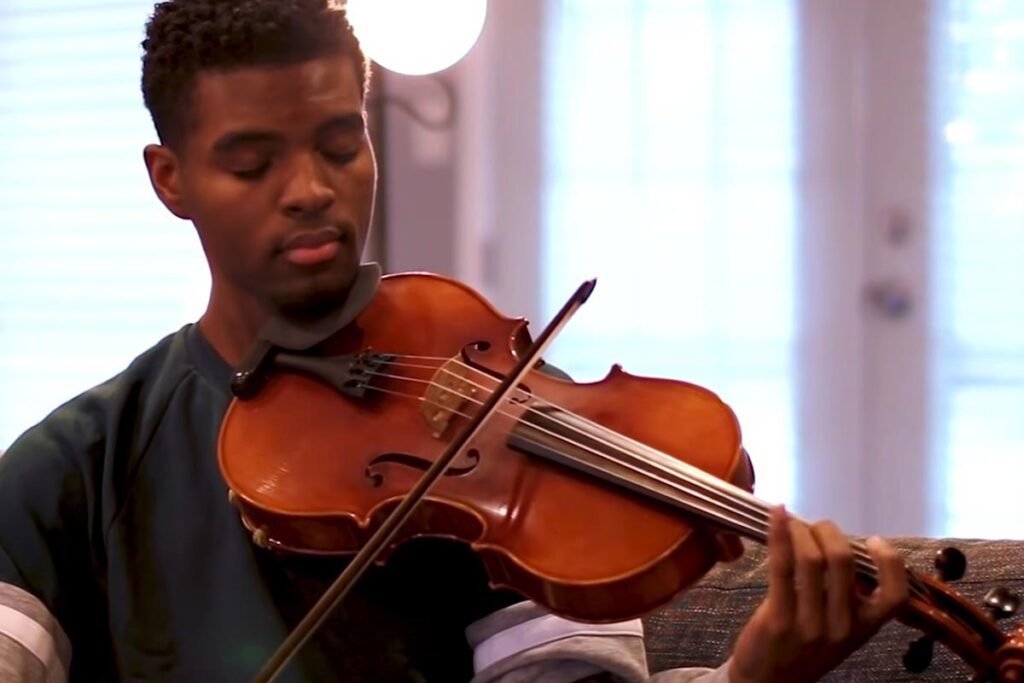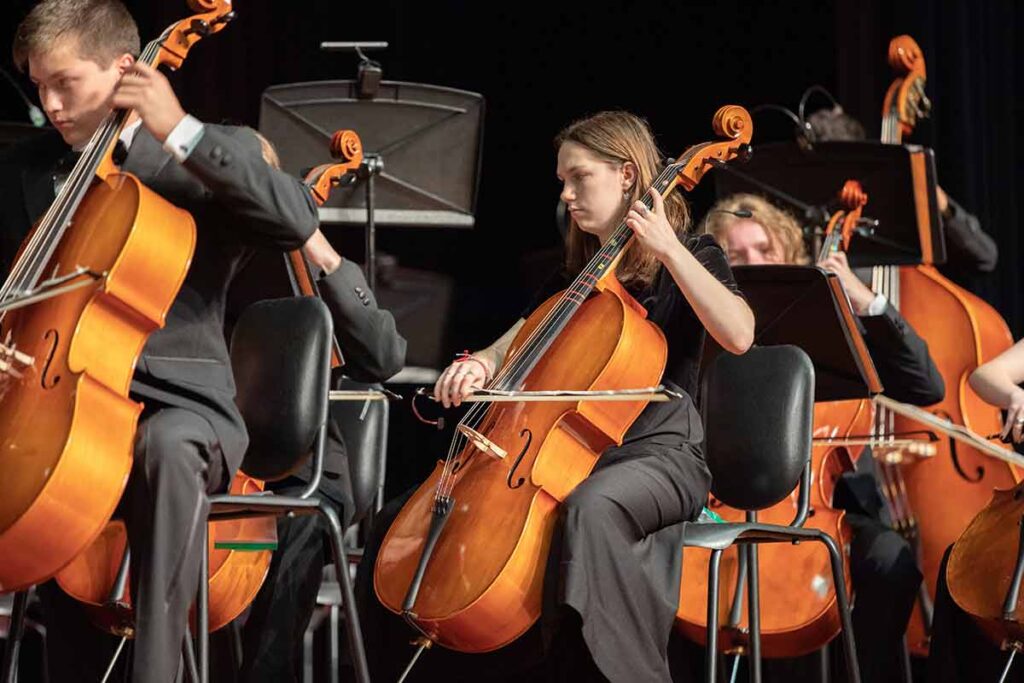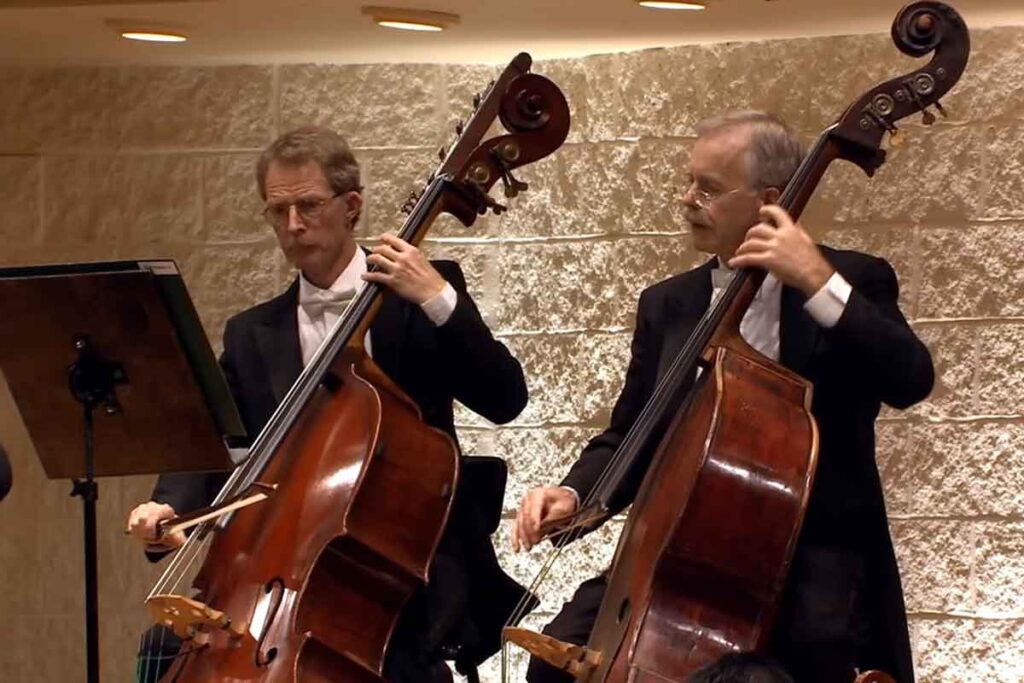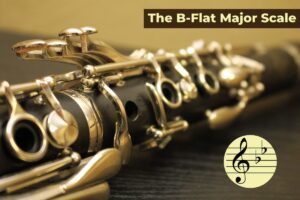The Orchestra String Instruments You Need to Know

The Orchestra string Instruments
The string instruments are part of the modern symphony orchestra.
Basically, the orchestra consists of different classes of instruments. These instruments are grouped into different sections. The sections depend on the way they make their sounds.
These sections are the string section, the woodwind section, the brass section, and the percussion section. It represents more than half of the total number of instruments in the symphony orchestra.
One of these sections is the string section. The string section is the orchestra’s largest instrument family.
Also, orchestral string instruments are one of the most prominent instruments in an orchestra. For instance, the violin and cello.
Obviously, the violin is the most popular string instrument in the orchestra. But we still have other string instruments in the orchestra string family.
You don’t have to worry because this post will reveal all the other orchestra string instruments that we have. We will also discuss them one by one.
Without further ado, let us go straight to our discussion. This is all about the orchestra’s string instruments.
What Are the Orchestra’s String Instruments?
The orchestral string instruments are string instruments used in the symphony orchestra.
These instruments are the violins, violas, cellos, double basses, and the harp.
The quality and depth of sound produced by these string instruments make them exceptional in the orchestra.
The violin, viola, cello, and double bass are the main string instruments in the symphony orchestra.
They are the heart of the string section and vary in size, range, and tone color.
The violin is the smallest string instrument, while the double bass is the largest.
These instruments are typically played with a bow. They sometimes play by plucking with their fingers.
The string section is an indispensable part of the symphony orchestra.
Their expressive range is great, and they are very versatile. They can create different dynamics, speed, tone color and a wide range of pitch.
Above all, these four major instruments of the string section blend beautifully with one another.
The harp is another string instrument used in the symphony orchestra. It is the only instrument of its specific type.
Also, the harp is only a regular pluck-stringed instrument used in the symphony orchestra.
Other stringed instruments with plucking, like guitars and mandolins, are occasionally used. Their usage is very common in operas.
The piano is also considered a string instrument. But it can also be classified as a percussion instrument.
String instruments are always visible in the orchestra’s front row.
6 String Musical Instruments in an Orchestra
In this section, we will discuss all the string instruments that we have in the orchestra one by one.
Typically, the four major string instruments in the orchestra are from the violin family. The violin family consists of violins, violas, cellos, and the double bass.
But other string instruments can be part of the orchestra, provided they are needed to perform a musical work.
As a result, other string instruments such as the harp and piano are occasionally added.
The Violin: Orchestra String Instrument
The violin is a hollow, wooden-bodied instrument with four strings running from top to bottom.
This is the most prominent and versatile instrument in the orchestra’s setup. Every detail used to construct the instrument influences the sound it produces.
In a typical orchestra setting, the violin section is further divided into two sections.
These are the first violin section and the second violin section.
The first violin section performs the highest notes and, in essence, the melody.
The second violin section is responsible for the next highest notes as well as the harmony and melody.
The violin is the heart of every orchestra. This bowed instrument is sometimes referred to as a fiddle in other types of music.
Tone Range of The Violin

The four strings are tuned to G3, D4, A4, and E5, respectively.
It covers up to four and a half octaves, from G3 to E7.
The violin is the smallest and highest-pitched member of the string section.
It is usually used for the melody because of its high pitch. Besides, it also supports other instruments harmonically and enhances the orchestra’s texture.
How is the violin played?
Someone who plays the violin is normally referred to as the violinist.
To play the violin, the violinist places the instrument on the left shoulder and uses his or her chin to hold it firmly.
The left hand is normally used by the violinist for fingering the notes.
This is done by pressing the strings down at a specific point to change their pitch.
The right hand is used to hold the bow used for bowing the strings.
The same hand is also used to pluck the instrument’s strings. The violin is also available for left-handers.
The bow is one of the major components of the violin. Of course, its construction influences the playability and sound of the instrument.
The violin creates sound with a bowed string. The air in its hollow, wooden body vibrates and resonates with these strings.
This happens when the violinist moves a bow across the strings of the instrument. This type of playing is called acro.
Playing the violin also includes techniques like pizzicato. This involves plucking the string with the finger.
We usually have at least fifteen to eighteen violinists in each section of the violin in a symphony orchestra.
The Viola: Orchestra String Instrument

This is another member of the orchestra’s string section. This instrument is constructed the same way as the violin.
In fact, it looks exactly like a violin, but its shape is slightly different. The viola is slightly bigger and heavier than the violin.
The instrument is the second smallest in the section after the violin. It is the alto, or middle, voice of the orchestra.
The viola sections are always in the middle part of the orchestra setting.
Tone Range of The Viola
The four strings on the viola are tuned to C3, G3, D4, and A4, respectively. They were tuned a perfect fifth apart.
It has a three-and-a-third octave range. This is from C3 to A6.
This range is said to be a moderate range for the stringed instrument.
The range of the viola is slightly lower than the range of the violin. But the range of the two instruments overlaps significantly.
The viola plays notes that are lower in pitch. It usually plays the harmony parts to support the violin’s melodic role.
Generally, it fills the gaps between the lower-pitched and higher-pitched instruments.
Violas have a special place in orchestral and chamber music. As the alto voice, the viola often plays the inner harmony between the cello and second violin.
The viola has a deeper, mellower, and lower sound compared to the violin. This is due to its low-pitch tuned string.
The tone of the viola is darker and less brilliant than the violin’s tone. But the viola’s tone is warm and rich.
How Is the Viola Played
Someone who plays the viola is referred to as the “violist.”
The viola is played the same way as the violin. And the bowing of the instrument is also the same.
Just like the violinist, the violist rests the viola on the left shoulder. Then use his or her chin to keep the instrument in place.
The left hand of the violist is used to press the viola strings to the board and change their pitch.
This serves as the primary hand for note-fingering. The viola is also available for left-handers.
We usually have about ten to fourteen violists in a symphony orchestra.
The Cello: Orchestra String Instrument

The cello is another bow-stringed instrument in the string section of the orchestra.
It is a hollow-bodied wooden instrument like other members of the violin’s family.
The cello looks like the violin or the viola, but it is a lot bigger than them. It also has four strings, like the rest of the violin family.
Physically, the cello is about 4 feet in length and was originally known as the “violoncello.” Cello is used as the short form of violoncello.
The instrument is tuned an octave below the viola and one and a fifth octave below the violin.
The cello section is located on the right-hand side of the audience in the front of the orchestra. This section is directly opposite the first violin section.
To learn more about cello, click the link here.
Tone Range of The Cello
The four strings on the cello are tuned to C2, G2, D3, and A3, respectively.
It has a three-and-a-third octave range. This is almost four octaves and is between C2 and C6.
Most often, cello music is scored in the bass clef and sometimes in the tenor clef. The tenor clef is not generally common, and the treble clef is used with the higher notes.
This instrument has a wide range of tones and a variety of dynamics. Hence, the cello is considered one of the most versatile instruments in the orchestra.
At times, the cello can serve as a supportive, dependable bass instrument. Thereafter, it can rise to reproduce the notes of a lovely tenor voice at other times.
How Is the Cello Played
Someone who plays the cello is referred to as the cellist.
The cello cannot be played like the violin or the viola because of its size. Hence, it is played in the upright position while sitting down.
The cellist allows the instrument’s body to rest between his or her knees.
The cello endpin is the part of the cello that touches the floor and supports the weight of the cello. The cello endpin is a spike or metal peg at the lower end of the instrument.
Then the neck of the instrument will rest on the shoulder of the player.
Just like the violin and the viola, the cellist’s left hand is used to control the strings of the instrument.
The right hand is used for the bow to bend the strings of the instrument. It is also used to pluck the strings of the cello.
We usually have about eight to twelve cellists in a symphony orchestra.
The double bass: Orchestra String Instrument

The double bass is also called the string bass, upright bass, or just “bass” for short.
It is the largest and lowest-pitched bowed stringed instrument in the orchestra.
The modern double bass is just over three meters high and is an octave lower than the cello.
Double basses are always on the stage’s right side.
This bass instrument is rarely used as a solo instrument. The bass is well known for providing the musical foundation for other orchestral instruments.
This makes it a prominent member of any orchestral setting.
Tone Range of The Double Bass
The four strings on the cello are tuned to E1, A1, D2, and G2, respectively. They are tuned in fourth apart. But the free strings of the instrument invert the violin strings.
The violin used E as the highest note and G as the lowest note. But in double bass, G is the highest note and E is the lowest note.
Sometimes, the fifth string, which is tuned to C, is added to the instrument. Also, a mechanism is sometimes attached to the E string to adjust it to play the lower C.
Either of the two systems is used with the double bass. This allows the instrument to always play an octave below the cello.
Because of the depth of the notes produced by the double bass, its music is written an octave higher than its sounds.
This is done to prevent the continued use of the many ledger lines below the bass clef.
The practical playing range of the double bass is C1 to C5.
How Is the Double Bass Played
Someone who plays the double bass is referred to as the bassist or the bass player.
A double bass cannot be played like a violin or viola because of its size. Though it looks exactly like them, it is much bigger.
The method used to play the double bass is very similar to the way a cellist plays the cello. But the instrument is taller than the player.
Due to the size of the bass, the bassist often stands to play the instrument. But the orchestra bassist normally sits on a tall stool to play the instrument.
While it looks like the other members of the string family, it is built differently.
Unlike the other members of the violin family, the double bass has a flat back. Its shoulders are not rounded as well but slope downward instead.
The sloping shoulder helps the player reach and move around the instrument’s strings easily. It prevents the effect of difficulty that the large size of the instrument can create.
The double bass is bowed just like the cello and any of the other bowed instruments.
But plucking is more frequently used to play the double bass than any other bowed instrument. This playing style enables the giant instrument to create a large variety of effects.
Double bass is often used in the symphony orchestra to play the cello part an octave lower.
We usually have about eight to ten bassists in a symphony orchestra.
The Harp: Orchestra String Instrument
This is a triangular-shaped instrument with several strings. These strings are vertically stretched across the triangular frame.
The harp is not a common instrument in the string section of the orchestra. It is also different from the other string instruments we have discussed.
The reason has been that its mode of construction is not the same as the violin or cello.
For instance, the harp has more strings than all the members of the violin family combined.
This gigantic string instrument also has pedals at its base. It is about 1.7 meters tall, 1.2 meters deep, and about 0.55 meters wide at the base.
The modern orchestra harp is a very sophisticated piece of machinery. It has seven strings for each octave, and there are forty-seven strings in all.
Each of the forty-seven strings of the harp is individually tuned. They are also made with different materials.
The higher string of the instrument is usually made of nylon, while the lower strings are made of gut.
The lowest strings are made with wound wire to make them heavier or add more weight.
The harp is always at the back of the second violin section and in front of the percussion.
Tone range of The Harp
The tone range of the harp is between C♭1 and G♭7.
How is the harp played?
A harp player may be referred to as a “harpist.”
To play the harp, the harpist sits in a chair with the harp leaning back against his or her right shoulder.
The harpist also ensures that the back of the harp is between his or her knees.
This sitting and harp positioning allow the harpist to reach the strings easily. It also allows him or her to use the foot pedals with ease.
The harp is normally played by plucking its vertical set of strings with fingers.
The strings of the triangular-shaped instrument are typically plucked. The plucking is done with the player’s first three fingers and thumbs.
The little fingers, or pinky fingers, are not used to play the harp.
The harpist uses his or her left hand to play the higher strings. Likewise, he or she used his or her left hand to play the lower strings.
The harp is not a bowing instrument like all members of the violin family.
The seven pedals at the bottom of the modern harp are normally used to adjust the length of the strings. This makes it possible for the harp to produce more notes.
The way they designed the harp allows the harpist to play eight notes at the same time. That is a four-note chord with the right hand and a four-note chord with the left hand.
We usually have at least one, sometimes two, harps in a symphony orchestra. But depending on the repertoire, we can have about one to six harps.
The Piano – Orchestra String Instrument

The piano is marginally considered a string instrument. This is because its sound comes from the strings.
But on a normal note, the piano is a percussion instrument.
It’s even listed as a keyboard instrument, alongside the organ and harpsichord.
The piano has a distinguished ability to play brilliant scales and rapid passages. It is also well known for its capability to play trills, arpeggios, octaves, and chords.
Tone Range of The Piano
The piano is a very versatile stringed, percussion, or keyboard instrument.
This instrument has a range from the lowest pitch to the highest pitch.
The piano pitches span more than seven octaves, or let’s say eighty-eight semitones.
How is the piano played?
The piano is played by hitting the strings with hammers. Hence, the piano is both a stringed and a percussion instrument.
Actually, the piano is always classified as a percussion instrument. But it is also a string instrument.
Many of us are very familiar with the piano. Besides its usage in orchestras, the piano is also an accompanying or solo instrument.
The strings of the piano are directly struck with padded hammers. The padded hammers are technically controlled by the keyboard mechanism.
Pianists play the piano by striking the keys on the keyboard with their fingers.
This action causes the padded hammers of the piano to strike the instrument’s strings.
The string then vibrates to set the column of air around it into vibration. These actions produce the sound of a piano.
All the eighty-eight strings of the piano are tuned to the note the corresponding key will play.
The piano has pedals that are used to control the instrument’s volume. Its pedals are also used to dictate the length of time its string vibrates.
Specifically, we play the piano by hitting its 88 white and black keys with our fingers.
This implies that this black and white keyboard instrument is a percussion instrument.
Conclusion: Orchestra string Instruments
You would notice that more of the orchestra’s instruments consist of strings.
The string instruments are always at the front of the orchestra. The violins are to the audience’s left, and the violas are in the center.
The cello and the double bass are always on the right side of the audience.
We also have a harp along with the piano that sits behind other bowed string instruments.
All these instruments come together to create the color and texture of the symphony orchestra.
But, due to their musical versatility, the string section remains the orchestra’s heartbeat.
At Phamox Music, we go all out for exactness and honesty. For this purpose, if by any means you found any possible glitch, be it factual, editorial, or something that we need to update, kindly contact us.
If you find the information provided in this post, Orchestra string Instruments, interesting and helpful, kindly share it with someone you know that might need it.







